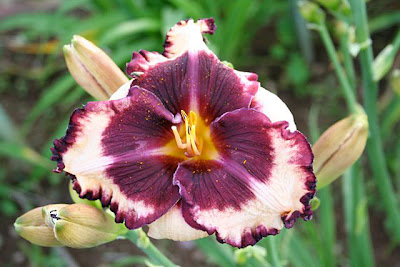
I'm with Irish poet William Butler Yeats who extolled life in the 'Bee loud glade' in his poem The Lake Isle of Innisfree.
I WILL arise and go now, and go to Innisfree,
And a small cabin build there, of clay and wattles made;
Nine bean rows will I have there, a hive for the honey bee,
And live alone in the bee-loud glade.
And I shall have some peace there, for peace comes dropping slow,
Dropping from the veils of the morning to where the cricket sings;
There midnight's all a glimmer, and noon a purple glow,
And evening full of the linnet's wings.
I will arise and go now, for always night and day
I hear lake water lapping with low sounds by the shore;
While I stand on the roadway, or on the pavements gray,
I hear it in the deep heart's core.

Now, Yeats was talking about the simplicity of life and its pleasures, and while he wasn't fixing particularly on pollinators, they're one of my fixations. Be they bees, butterflies, hummingbirds, beetles or flies, I'm a fan, although of course it's the hummers, the bees and the butterflies that get most of the love in most of our gardens.

Ours is a pollinator friendly garden, and always has been even before the word hit in the media that many wild pollinators were in trouble. I long, long ago chose to be an organic gardener, although I've succumbed to chemical warfare on occasion (yeah, goutweed, I'm looking at YOU!). But we choose to grow the plants on our property without using pesticides or chemical fertilizers, and to create a haven that is pollinator friendly.

Because we have pastures and paddocks and adjoining woodlands on our property, there are lots of places where we simply let the wild plants grow; so you'll see thistles and nettles, goldenrods and asters, alders and mountain ashes and other plants that some might not adore.
There are also plenty of deliberately planted perennials, annuals, shrubs and trees to entice pollinating creatures. One of my favourite pollinator-magnets is flat sea holly, Eryngium planum.

We have several different climbing honeysuckles in our garden, all of which are much appreciated by the hummingbirds that hang out here all summer. We have no idea how many hummers are here, but I provide nectar in feeders for them each day along with myriad flowers.

Pollinators are especially attracted to purple, red and orange flowers, and we happen to have plenty of those growing around the gardens. One of my personal favourites is Monarda, or bee balm, and we have four or five different varieties. This is 'Jacob Kline', which is extremely red and doesn't show it nearly well enough in photos.

Astilbes attract many different bees and flies, and they began to attract me three or four years ago. My biggest problem is that I don't remember which astilbes I have...there's a white one, and a light pink one, and a deep magenta one, and a wine one, and and and...no matter. The garden is good to them because they'll take sun or shade as long as the soil is moist. Moist is something we have in great abundance this summer especially.

Although not as showy as astilbes, or echinaceas, or some of my other favourites, astrantia, or masterwort, is one of the most beautiful of perennials and one more people need to embrace. The flowers are so geometrically attractive, the colours wonderful, and the bloom profuse. I rarely get a picture of one of my astrantias without a fly or bee on the blossom.
 As I said above, we have a lot of different kinds of plants, and mix many of them together in each bed around the place, so the whole property is a pollinator friendly garden. These knautia or pincushion flowers will bloom for a long time especially if I'm diligent about deadheading, which sometimes happens.
As I said above, we have a lot of different kinds of plants, and mix many of them together in each bed around the place, so the whole property is a pollinator friendly garden. These knautia or pincushion flowers will bloom for a long time especially if I'm diligent about deadheading, which sometimes happens. We all want to have a full season of colour in our gardens to please our own selves, but also to help support the pollinators. This 'Blaze' geum is in bloom now, nearly a month after some of its relatives finished up, and is a bee magnet. In the spring, I don't mow or kill the dandelions or coltsfoot, because these early blooming wild plants provide vital nutrition for those early awakening pollinators such as some of the bees.
We all want to have a full season of colour in our gardens to please our own selves, but also to help support the pollinators. This 'Blaze' geum is in bloom now, nearly a month after some of its relatives finished up, and is a bee magnet. In the spring, I don't mow or kill the dandelions or coltsfoot, because these early blooming wild plants provide vital nutrition for those early awakening pollinators such as some of the bees.I know that some are allergic to bees, wasps, etc, and for that very good reason aren't crazy about having them around. But in the more than a decade that I've been gardening here, I've been stung exactly once by a bumblebee, and that was because I stepped on her in my bare feet. I've had one wasp sting too, but far more encounters with the nettles, and the nettles bother me more than an insect sting. The hummingbirds greet me like part of the garden (and come to the window to complain if we're slow in filling their feeders), and the butterflies just do their thing. And I get to feel like I'm giving back something to nature by creating this bee/hummingbird/other pollinator-loud glade. And that's one of the reasons that I garden.













































